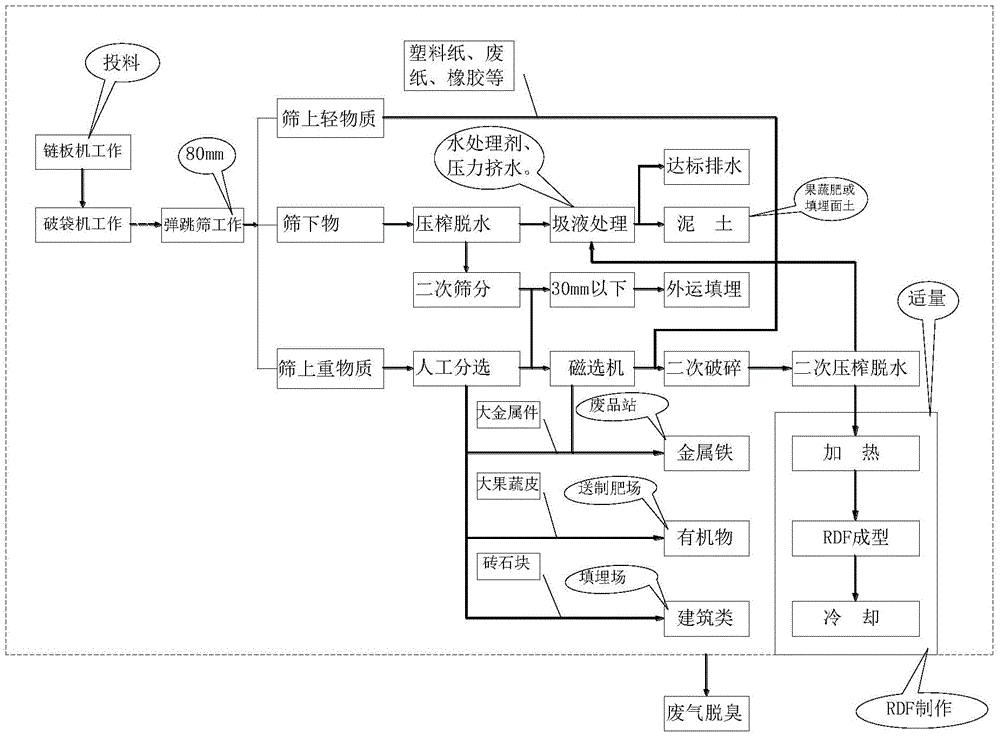Human household garbage disposition and recycling method
A technology for domestic waste and reuse, applied in the field of waste resource recycling, can solve the problems of high cost of harmful exhaust gas purification and secondary pollution, and achieve the effects of reducing energy consumption, improving cycle time, and reducing investment.
- Summary
- Abstract
- Description
- Claims
- Application Information
AI Technical Summary
Problems solved by technology
Method used
Image
Examples
Embodiment 1
[0024] A method for disposing and reusing human domestic waste, comprising the following steps:
[0025] 1) The 1,000 kg bagged garbage is transported to the bag breaking machine by the chain plate machine for bag breaking treatment, and then screened through a bouncing sieve with a screen mesh of 80mm, and the garbage is screened into light materials on the sieve and heavy materials on the sieve Substances and undersieves, including 300 kg of undersieves, 300 kg of heavy materials on the sieve, and 400 kg of light materials on the sieve.
[0026] 2) After secondary crushing and dehydration of the light material on the screen, the resulting product is made into RDF; the heavy material on the screen is first sorted into 20 kg of large metal parts, 50 kg of large fruit and vegetable skins and masonry After the material after the magnetic separator is crushed for the second time, squeezed and dehydrated for the second time, the resulting product is made into RDF; the underscreen ...
Embodiment 2
[0029] A method for disposing and reusing human domestic waste, comprising the following steps:
[0030] 1) The 1,000 kg bagged garbage is transported to the bag breaking machine by the chain plate machine for bag breaking treatment, and then screened through a bouncing sieve with a screen mesh of 80mm, and the garbage is screened into light materials on the sieve and heavy materials on the sieve Substances and undersieves, including 350 kg of undersieves, 280 kg of heavy materials on the sieve, and 370 kg of light materials on the sieve.
[0031] 2) After secondary crushing and dehydration of the light materials on the sieve, the resultant is made into RDF; the heavy materials on the sieve are first sorted into 25 kg of large metal parts, 48 kg of large fruit and vegetable skins and masonry After the material after the magnetic separator is crushed for the second time, squeezed and dehydrated for the second time, the resulting product is made into RDF; the underscreen is sq...
Embodiment 3
[0034] A method for disposing and reusing human domestic waste, comprising the following steps:
[0035] 1) The 1,000 kg bagged garbage is transported to the bag breaking machine by the chain plate machine for bag breaking treatment, and then screened through a bouncing sieve with a screen mesh of 80mm, and the garbage is screened into light materials on the sieve and heavy materials on the sieve Substances and undersieves, including 400 kg of undersieves, 250 kg of heavy materials on the sieve, and 350 kg of light materials on the sieve.
[0036]2) After secondary crushing and dehydration of the light material on the screen, the resulting product is made into RDF; the heavy material on the screen is first sorted into 28 kg of large metal parts, 46 kg of large fruit and vegetable skins and masonry block 25 kg, and transport the residue to the magnetic separator for sorting. After the material after the magnetic separator is subjected to secondary crushing and secondary pressin...
PUM
 Login to View More
Login to View More Abstract
Description
Claims
Application Information
 Login to View More
Login to View More - R&D
- Intellectual Property
- Life Sciences
- Materials
- Tech Scout
- Unparalleled Data Quality
- Higher Quality Content
- 60% Fewer Hallucinations
Browse by: Latest US Patents, China's latest patents, Technical Efficacy Thesaurus, Application Domain, Technology Topic, Popular Technical Reports.
© 2025 PatSnap. All rights reserved.Legal|Privacy policy|Modern Slavery Act Transparency Statement|Sitemap|About US| Contact US: help@patsnap.com

